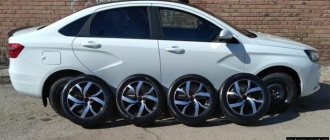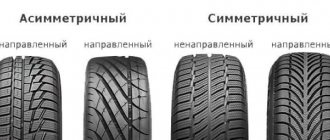The progressive car Lada Vesta has existed on the Russian market for enough time to be able to objectively evaluate all its shortcomings.
Let's start with the fact that the product of the domestic automotive industry more than met the expectations of its fans due to:
- good handling, as for a car in this segment;
- spacious interior and spacious luggage compartment;
- decent level of passive safety;
- stylish and fast-paced exterior;
- many practical and useful options that were first implemented by AvtoVAZ.
However, the ideal car has not yet been invented, and the “sharks” of the global automotive industry have shortcomings and disadvantages in any model. They are the ones that arouse genuine interest among many experts and skeptics. Let's try to identify all the disadvantages of this machine.
Disadvantages in the car interior
From the first minutes of ownership, the new Vesta does not allow the owner of the Lada Vesta to direct accusations of assembly flaws against it. The cabin is quiet and comfortable, as also expressed by numerous reviews from the owners. However, over time, all sorts of shortcomings begin to “creep out”. The most common manifestations are “crickets” and a characteristic squeak, which indicates the manufacturer’s savings on sealing elements.
The steering wheel lining “gives up” very quickly, and the paint on it begins to wear off. Shortcomings in the interior began to be present due to the manufacturer’s use of low-quality plastic for finishing the interior panels; this can be encountered when studying the reviews of the owners. The elements do not look entirely aesthetically pleasing “thanks” to the designated texture of the material. Some owners “defend” Lada Vesta by promoting the idea that panels made of such material are easy to clean. We continue to identify all the disadvantages.
Next, let's turn our gaze towards the instrument panel. There is a lack of information here. The reason for this was the small instrument indicators, and the upper edge of the dashboard was obscured by the edge of the “well” and partly by the steering wheel.
Comfort in the cabin cannot be considered a disadvantage; rather, it is a significant advantage of the Russian model. Here you should “close your eyes” to the intricate design of the driver’s armrest and the absence of this element for the passenger. These are the pros and cons of the model's interior.
Lada Granta push-button radio
Grant instrument cluster
Fuse box Lada Granta
Less than a week has passed since we received the car, and our Vesta Cross has already managed to visit the technical center of the official dealer to check and repair the first “jambs”. Or maybe it would have been better to immediately write a claim and demand... a refund for the car? The news about the decision of the Supreme Court of the Russian Federation allowing such a decision was published just a day before the events described and promised considerable hype of views and comments.
Have a question about Vesta Cross? Ask Drom and we will find the answer!
The main disappointment in the new Vesta SW and SW Cross station wagons based on the results of the first test drive in Sochi for me personally was the 1.8-liter engine in combination with a manual transmission. Vesta with such an engine was first tested in our test back in the spring, but at that time I hoped that it was the “robot” on that test sedan that was the main reason for the sluggish nature of the more powerful car in comparison with the proven 1.6-liter version. The possibility of incorrect running-in of test vehicles cannot be ruled out (in fact, they immediately fall to the “tear to pieces” of meticulous journalists). Therefore, we started operating our Cross with a run-in regulated by the “Operation Manual” - perhaps this will help to more fully reveal the potential of the engine?
The factory regulates the running-in mileage at 2000 km. By modern standards - a lot. But at least the good thing is that there are no unnecessarily strict restrictions for this period
But first, I had to use a quiet and gentle Russian word to remember the one who ordered the introduction of a “renault” algorithm for controlling the on-board computer with two keys on the steering column lever in Vesta. No, when you read the instructions three times and make several independent attempts to reset the odometer or set the clock, everything becomes clear, but you can’t intuitively guess the necessary actions. Especially if the dashboard starts “catching bunnies” and “talking” to you with mysterious symbols instead of words.
This was the first reason for early contact with the service, but not the only and not the main one. In addition to the glitches of the on-board computer, after a couple of days of driving on the slushy roads of Moscow and the Moscow region, the work of the wipers began to irritate me. This is due to the fact that at the end of the cleaning cycle they do not stop at the bottom point, but make a small jerk up one and a half centimeters. It would seem like a trifle, but this extra movement is noted in the mind every time and eventually begins to bother.
Checking the car locking with the key fob revealed another unpleasant nuance: three of the four door handles may remain in the pulled position when trying to open the doors from the outside.
And finally, when starting the ERA-GLONASS testing procedure, the system generated the following alert:
Is it really faulty? Bearing in mind that on our white Vesta ERA also did not work correctly (there is a connection with the operator, but the coordinates of the car are determined incorrectly), I call the dealer and make an appointment for diagnostics and, possibly, repair of all the jambs. To them, in addition to the above, a purely dealer version was added - with the installation of additional equipment (more precisely, with the sticker of a tint film). On three of the five tinted glasses under the film, upon closer examination, small grains of sand were discovered, due to which light “bald spots” began to appear. In addition, in the previous post I mentioned the poor sizing of the edges, which only got worse a few days later: “lack of sizing” appeared along the entire edging of the trunk glass.
Sorry for the quality of the photo: due to the re-tinting, the car had to be returned in the evening to be left overnight. The associated inconvenience is returning home on foot (through all of Moscow, by the way!) and the same independent trip the next day to pick up a supposedly repaired car. Let me remind you: only a week has passed since the purchase...
As a result, out of five issues, only one can be considered corrected: the tinting (and even then, after a while, the “un-glued” began to appear on the edges again, but at least the grains of sand were no longer visible). Two more issues were half corrected. Thus, ERA-GLONASS still does not launch the testing procedure, but at least contacts the emergency service operator and reliably transmits the coordinates of the vehicle. And the door handles were simply greased with the same white lithium grease that was so rudely sprayed on the door hinges before the new car was delivered. But this time traces of grease were also found on the side windows! When handing over the car, the mechanic tried to quickly wipe them off... with a cellophane cover removed from the steering wheel. It turned out, to put it mildly, “not very good.”
Traces of whitish dust and prints of dirty hands were found in the interior in the glove compartment area.
Later, when the sun came out for a while, the dirty dashboard appeared in all its “glory.” Damn, even in “Uncle Vasya’s” garage the car remains cleaner after “repairs”!
At the same time, the on-board computer itself remained with all its glitches: as at the beginning of sales of Vesta, all non-standard or simply new malfunctions first need to be documented and sent with the appropriate request (“Hello, hello, boss, what should we do, what should we do?” - apparently , with this, as I understand it) to the factory. Then wait for an answer. And you will probably have to go to the service center again. Or maybe you won’t have to, if the flickering symbols are not recognized as a malfunction - as is the case with the wipers. Yes, they didn’t do anything with them at all, considering their work to be a normal phenomenon.
The left photo shows the position of the wipers on our “blonde”. On the right - this is where the windshield wipers freeze on the red one.
Yes, the last pair of pictures is not accidental: it was precisely these days that the white Vesta from the first shipment, which appeared in our editorial office almost exactly two years ago, ended up in Moscow (travelling from the Urals to Krasnodar), and we, of course, did not fail to compare the two Vestas with your own eyes and see what has changed/improved in the model over the two years of production. But we will talk about this in the next entry of our blog - as they say, like and subscribe to updates!
Best regards, Alexey A_ST
Have a question about Vesta Cross? Ask Drom and we will find the answer!
Robotic transmission "AMT"
According to reviews from experts and ordinary owners, this unit is not the most successful in the Lada Vesta transmission range. This box, in fact, is a modified version of the VAZ-2108 manual transmission. Units of this family always “complained” about oil starvation, where the upper shafts especially “got it”. In addition to all this, the box is deprived of the required amount of lubricant.
For the AMT, the manufacturer used a clutch from the famous Valeo brand. Despite this preference, the unit may wear out by 80 thousand km and require replacement. This procedure is not cheap, so it will cause a lot of indignation among the owner. Owner reviews on this matter are not happy.
Many drivers of the Lada Vesta SV Cross have noticed failures during gear switching, as well as the presence of delays in the transition of the unit to the second stage. The likelihood of feeling negative emotions during acceleration is quite high here, especially during the first trip.
Tendency to pollute
The area near the hood lock is characterized by a large gap, and therefore a large amount of dirt penetrates into the engine compartment. This forces caring owners to install additional protective seals. The body itself also suffers from rapid contamination. The reason for this is the enlarged wheel arches, which provokes the accumulation of dirt on the side panels, including on the fashionable X-shaped prints. The absence of sides on the windshield leads to contamination of the side window line.
The owners of the Lada Vesta SV Cross noticed another defect in the side windows. We are talking about extremely poorly selected seals, due to which dirt can penetrate inside the door panel, causing corrosion over time, many reviews from owners indicate this.
We should not forget about low-effective glass cleaners, which caring owners replace without a shadow of a doubt. Regular wipers are unable to cope with their own task. In addition, over time they begin to leave scratches on the glass surface. What other pros and cons does Vesta have?
Results of the 60-hour endurance race
Brake pad wear:
- Hyundai Creta - 1.83 mm/1000 km. That is, their resource is about 45,000 km.
- Ford Focus - 2.5 mm/1000 km (33,000 km).
- Lada Vesta SW - 3.17 mm/1000 km (23,000 km).
- Lada Vesta SW Cross - 3.69 mm/1000 km (21,000 km).
Before the start of the tests, the engine oil in all cars was changed to new one. At the end of the marathon, oil samples were taken and sent to the laboratory for analysis:
- In Lada Vesta SW, Lada Vesta SW Cross and Ford Focus, all indicators are normal. There is silicon, which indicates the infiltration of the finest road dust. This is normal after a certain number of kilometers of mud have been covered.
- Not only silicon was found in the Hyundai Creta, but also an increased content of copper. Judging by its quantity, the engine was wearing out three times more intensively than during normal operation.
We were looking for the maximum temperature at which cars start. To simulate short city trips in winter, the cars were frozen to -25 °C, then the engines were started. They turned it off when the coolant reached 40 °C. Then - freezing again and starting again. And so - ten cycles for each machine. After completing the test cycle, oil samples were taken:
- An increased iron content was observed in the engine oil of all cars - this is a direct consequence of engine wear.
- In Hyundai Creta, in addition to the high metal content in the oil, its viscosity has dropped so much that it can harm the engine. Factory oil is not ready for such conditions.
- Lada Vesta SW, Lada Vesta SW Cross and Ford Focus also showed high levels of metals in the oil, but the situation is better.
Conclusion
(link to ZR article):
- Ford Focus swallows even serious potholes without problems, the engine tolerates heavy loads and high speeds well. But on a snow-covered highway, the Focus instantly becomes covered in snow, and the modest ground clearance forces you to be especially vigilant on uneven roads.
- Hyundai Creta behaved excellently on broken dirt roads and gave no cause for concern in ruts. But it lacks stability on slippery roads, which is especially noticeable compared to other cars. A glitch in the tire pressure monitoring system also alerted me. The most serious complaint arose after oil analysis. The Creta does not tolerate frequent cold starts and constant high revs.
- Lada Vesta SW is a real SUV. The ground clearance is higher, the energy intensity of the suspension is higher. It is necessary to understand the voltage in the network. Devices are not allowed to turn off even at the highest speeds! The same goes for the Cross version.
- The Lada Vesta SW Cross is annoying due to excessive body rocking, and low-profile tires reduce the effect of the impenetrable chassis - a hernia, a punctured tire and a jammed wheel are witnesses to this. The engines of both Wests proved to be resistant to heavy loads. It was their engines that showed the least wear - even after cold starts.
Heating efficiency:
- Ford Focus
- Hyundai Creta
- Lada Vesta SW and Lada Vesta SW Cross
The Kar-index takes into account operating costs for 70,000 km - these are registration and technical inspection fees, transport tax, MTPL costs, fuel costs and scheduled maintenance, as well as sales losses:
CAR MILEAGE DURING THE MARATHON, km
| FORD FOCUS | HYUNDAI CRETA | LADA VESTA SW CROSS | LADA VESTA SW | |
| Total mileage | 2724 | 2695 | 2578 | 2632 |
| cobblestone road | 565 | 565 | 536 | 560 |
| Braking | 573 | 560 | 539 | 524 |
| Driving at maximum speed in third gear | 1099 | 1098 | 1084 | 1099 |
| "Mountain road | 182 | 136 | 130 | 204 |
| Dirt road | 305 | 336 | 289 | 245 |
NOISE AT SPEED 120 KM/H, dB
| FORD FOCUS | HYUNDAI CRETA | LADA VESTA SW CROSS | LADA VESTA SW | |
| With box on the roof | 74,4 | 73,95 | 75,7 | 75,6 |
| Without boxing | 69,9 | 69,4 | 71,3 | 71,7 |
| Difference | 4,5 (6,4%) | 4,55 (6,5%) | 4,4 (6,1%) | 3,9 (5,4%) |
FUEL CONSUMPTION
| FORD FOCUS | HYUNDAI CRETA | LADA VESTA SW CROSS | LADA VESTA SW | |
| Total spent | 315.00 l | 337.35 l | 333.06 l | 337.15 l |
| Average consumption for the entire marathon | 11.56 l/100 km | 12.52 l/100 km | 12.91 l/100 km | 12.81 l/100 km |
| Average consumption at a speed of 120 km/h with roof box | 10.46 l/100 km | 10.72 l/100 km | 11.19 l/100 km | 10.94 l/100 km |
| Average consumption at a speed of 120 km/h without roof box | 9.98 l/100 km | 9.84 l/100 km | 10.15 l / 100 km | 10.11 l/100 km |
WEAR OF TIRES AND BRAKE PADS
| FORD FOCUS | HYUNDAI CRETA | LADA VESTA SW CROSS | LADA VESTA SW | |
| Average tire wear | 3.62 mm / 1000 km | 2.53 mm / 1000 km | 3.25 mm / 1000 km | 3.33 mm / 1000 km |
| Theoretical tire life during normal use | 21,000 km | 32,000 km | 25,000 km | 23,000 km |
| Brake pad wear | 2.5 mm / 1000 km | 1.83 mm / 1000 km | 3.69 mm / 1000 km | 3.17 mm / 1000 km |
| Theoretical pad life during normal operation | 33,000 km | 45,000 km | 21,000 km | 24,000 km |
Let us remind you that the editorial fleet includes a Lada Vesta sedan in the Luxe configuration. This car has already covered 50,000 km. Previously, experts from the auto magazine told us what problems the editorial Vesta had in recent times.
Keywords: Lada Vesta Cross
+14
Share on social networks:
Found an error? Select it and press Ctrl+Enter..
Stabilizer struts Lada Vesta
In the rear suspension of the Lada Vesta SV Cross, these elements do not boast of their reliability, and therefore, the owners “transferred” them to the category of consumable components. After the 3,000th mileage, they begin to knock. The rubber bands of the stabilizer can also remind themselves of themselves, annoying the owner with an annoying squeak on uneven surfaces.
Lada Vesta SW Cross: five pros and five cons
Our car enthusiasts have been waiting for the appearance of the Lada Vesta station wagon for almost two years. And if the Vesta SW station wagon itself was received positively, then a serious discussion flared up regarding its all-terrain version Lada Vesta SW Cross.
Some, not without reason, considered the “Cross” to be a real breakthrough; others, on the contrary, still sincerely do not understand what the point is in a station wagon slightly raised above the ground, which at the same time costs more than the standard one. As usually happens, there is some truth in the words of both. Let's try to figure it out. Let's start with the pros.
1. Lada Vesta Cross SW is the most beautiful domestic car.
Judging design has always been a subjective matter. But you really can’t deny the beauty of the all-terrain station wagon from Lada. So many will buy SW Cross just because of its appearance. But in fact, the VAZ team followed a long-trodden path - they took an ordinary station wagon, installed large wheels on it (in this case, 17 inches) and dressed it in a protective body kit “all around” made of unpainted plastic.
Despite the standard solutions (remember the same Volkswagen Passat Alltrack), it turned out so great that compared to the all-terrain SW Cross, the regular Vesta station wagon looks rather modest.
2. Even the Renault Kaptur does not have such ground clearance.
Of course, the “French” Kaptur looks like a real crossover, but, if you rely on real and not passport data, it is a couple of millimeters closer to the ground than the Vesta Cross SW. What can we say about the Hyundai Creta with its 19 cm ground clearance. Vesta SW Cross - for comparison - has exactly 203 millimeters of free space under the “belly”.
It may not be possible to make full use of them without all-wheel drive, but a domestic station wagon is quite capable of taking a snow-covered yard by storm or driving through streets flooded after another rainstorm. The main thing is to remember that the black “lip” under the front bumper is one piece with the license plate area and the fog lamp sockets. If the off-road rides do not end according to the scenario, replacing it will not be as cheap as we would like.
3. Lada Vesta SW Cross drives like no one else has ever dreamed of.
The VAZ team worked on the suspension settings of their all-terrain station wagon for a long time. What can we say if, according to official data, about 40 options for shock absorber settings were tested. To the credit of the engineers and testers, they did an excellent job. Everyone who has already tested the SW Cross was unanimous - the station wagon drives great.
If the Vesta with a sedan body, which at one time also received a lot of praise for its omnivorous suspension, copes with all road obstacles without problems, then the SW Cross station wagon also feels confident off-road. You have to take care of low-profile tires rather than suspension. The latter doesn’t care at all, which is extremely pleasing in our harsh conditions.
4. A 1.8-liter engine is offered for the Lada Vesta SW Cross.
Let's face it - no one will buy a SW Cross with a 1.6-liter power unit. Whatever one may say, its 106 “horses” are not enough. The main demand will be for the version with a 1.8-liter engine producing 122 horsepower. Moreover, Lada dealers will probably casually mention that in the class of budget cars only SW Cross can boast of a power unit of such a volume. Indeed, the initial engine in a couple of Hyundai Solaris and Kia Rio is a modest 1.4-liter engine, which has less than a hundred “horses”.
The second engine available to the “Koreans” has a volume of only 1.6 liters. As for the Renault Kaptur and Hyundai Creta, which can also be 2-liter, the Vesta SW Cross is not a competitor to them. Crossovers with a 2-liter engine are significantly more expensive.
5. Lada Vesta SW Cross can be bought only because of one trunk.
The trunk of the new product was truly a success. In itself, its volume of 480 liters is not amazing, if only because the same amount is allocated for luggage in a regular station wagon and sedan version.
The SW Cross trunk excels in another way – because of its thoughtfulness. Packages from the supermarket will no longer “travel.” They can be secured with a special holding mesh. There will be something to put in the rather roomy niches on the sides of the trunk. But that's not all. A 12 V socket, hooks, and two handles for closing are just a small part of the “goodies” offered by SW Cross. Having penetrated underground, the future owners of an all-terrain station wagon will, not without pleasure, discover several spacious organizing trays there. In a word, the trunk of the Lada Vesta SW Cross can be the envy of station wagons that cost 2-3 times more.
But, as it turned out, with all its undeniable advantages, Vesta SW Cross is not without significant drawbacks. Moreover, not all of them lie on the surface. It is all the more important to know about them before purchasing a car.
1. Beauty... Today there is, but tomorrow...
Lada Vesta sedans hit our roads quite recently, but even this time was enough to understand the obvious - VAZ has serious problems with the quality of painting of plastic parts. You can verify this by looking at the Vesta, which has already covered 30-40 thousand kilometers. Their bumpers don't look nearly as attractive as they did a year ago. This topic is also actively discussed on specialized forums. Factory workers are aware of the problem, but it is unlikely to be resolved quickly. So the SW Cross from the first batches may not look so nice in a year or two.
2. The 1.8-liter engine does not make the Vesta SW Cross a fast car.
In terms of volume, the VAZ engine is indeed 200 cubic meters larger than competitors’ engines. But volume alone does not guarantee an advantage in traffic light races. You need horsepower and torque. And according to these indicators, SW Cross is far from being a leader. It is not surprising that the “Koreans” with 1.6-liter power units accelerate up to a hundred kilometers per hour faster. Their maximum speed is also higher than that of the Vesta sedan.
The all-terrain station wagon on its large 17-inch wheels promises to be even a little slower. Another drawback of the 1.8-liter SW Cross engine is sluggishness at low speeds. It turns out that in urban conditions you will have to constantly switch to a lower gear, which will negatively affect fuel consumption.
3. There are many heating options, but little use.
The fact that Vesta SW Cross has three-stage heated front seats is good. One cannot help but welcome the fact that the rear sofa in the domestic station wagon is heated. It would seem that everything is fine, but...
Remember how your winter driving morning begins. Time is running out, the car, at best, warms up for a couple of minutes at idle, after which children come out of the entrance, who need to be at school in five minutes. And, unfortunately, they get into a cold car. Heated rear seats don't help. Considering that children sit in special chairs, it turns out to be useless. A remote engine start (such as the Renault Kaptur) could make the meeting with the car warmer, but such a useful option is not offered for the SW Cross in principle.
4. You can drive Vesta SW Cross cheaply.
When buying a relatively affordable car, we a priori believe that its operation should not be too costly. In the case of SW Cross, it is also unlikely that you will go broke, but the costs may still exceed the expected level. Take, for example, the 17-inch wheels, which also make the all-terrain station wagon look so cool. Everyone admires them, but few people remember that they will have to be changed before the winter season.
The price tags for a set of 15-inch and 17-inch wheels, as you might guess, differ quite significantly. In theory, the SW Cross can be equipped with more affordable “sixteenth” wheels on stamped rims with hubcaps, but then why bother paying extra for the most beautiful Lada? And the ground clearance will also decrease.
5. Vesta SW Cross is inexpensive, but with that amount in your pocket it’s quite possible to ask the price of foreign cars.
One of the biggest drawbacks of the SW Cross is the lack of a full automatic transmission. The AMT robot is not able to replace it, so those who need a car exclusively with an automatic transmission will not look towards the SW Cross. Fortunately, Rio, Solaris and Polo have automatic versions at the same price. Moreover, instead of a new station wagon, you can buy a used car of a higher class for the same money. Moreover, this will not be a well-worn “ten-year-old”, but a completely fresh representative of the golf class. And if you choose a Ford Focus or Kia Ceed, you can even find a station wagon version. It is possible that the found copy will still be under warranty.
As usual, time will put everything in its place. A few months will pass - and the first official data on Vesta SW Cross sales statistics will impartially tell whether our car enthusiasts are ready to turn a blind eye to the shortcomings of the all-terrain station wagon. Perhaps the disadvantages of SW Cross will seem far-fetched to most. Then – who the hell is it – “Cross” will fill our roads in a couple of years. Let's wait... We'll see...
Price for the new Lada Vesta SV Cross:
| Equipment | Price, rub. | Engine l/hp | Box | Drive unit |
| Luxe 1.6 MT (petrol) | 755 900 | 1.6/106 | 5 tbsp. MCP | front |
| Luxe 1.8 MT (petrol) | 780 900 | 1.8/122 | 5 tbsp. MCP | front |
| Luxe 1.8 AT (petrol) | 805 900 | 1.8/122 | 5 tbsp. Robot | front |
| Luxe Multimedia 1.6 MT (petrol) | 779 900 | 1.6/106 | 5 tbsp. MCP | front |
| Luxe Multimedia 1.8 MT (petrol) | 804 900 | 1.8/122 | 5 tbsp. MCP | front |
| Luxe Multimedia 1.8 AT (petrol) | 829 900 | 1.8/122 | 5 tbsp. Robot | front |
| Luxe Prestige 1.8 MT (petrol) | 822 900 | 1.8/122 | 5 tbsp. MCP | front |
| Luxe Prestige 1.8 AT (petrol) | 847 900 | 1.8/122 | 5 tbsp. Robot | front |
New Lada Vesta SV Cross video test drive:
Previous posts: « History of the Barkas B1000 | Polishing car headlights »
Related posts:
LADA, Station wagons
Lada Vesta SW Cross test drive
Car concept
Lada Vesta Cross
Tags: Lada Vesta SV Cross
Exhaust system
Here all the disadvantages come down to the sagging of the rubber suspensions holding the muffler. After 20 thousand km, owners begin to hear the impacts of exhaust system elements on the central tunnel.
The resonator can also bring a surprise. This component often burns out at the mileage mark of 60 thousand km. The exhaust exhaust pipe brackets require special attention. This is where breakdowns can occur because the components are held in place with less-than-ideal steel nuts.
About other little things about Vesta
This car is not so bad, and like any other it has pros and cons. Below are some minor shortcomings that can be classified as nit-picking rather than serious flaws. Still, there is nowhere to “hide” from them, so let’s look at this list in more detail:
- small width of the pedal assembly;
- low visibility through the stern glass;
- breakdowns in the windshield heating system;
- increased sensitivity of the ABS unit, which causes some discomfort in driving the car;
- ambiguities in the central locking algorithm.
AvtoVAZ’s policy has recently been reduced to eliminating defects identified during operation. This is the right position to improve the quality of your own products.
Lada Vesta is a VAZ, not a foreign car - Vesta's jambs that everyone should know about!
Today there is an opinion that Lada Vesta is not an AvtoVAZ, but a foreign car, but this is not so. Now we will figure out why.
If you have ever owned a car manufactured by AvtoVAZ, then you understand that it has a number of features that are already history in the modern world.
Usually AvtVAZ or TAZ cars are carts that are designed to take you from point a to point b. Yes, of course, we must admit that the Lada Vesta is a giant leap towards foreign cars. Even in safety tests, it showed good results. But if you think that everything about it is perfect and this is really a car at the level of a foreign car, then you are very mistaken. Of course, it has a lot of new electronic toys, which not all used foreign cars have. But some of all this paraphernalia is needed only at face value, and you simply won’t buy much of it yourself, because not everyone will dare to take Vesta at maximum speed.
Let's look into the flaws and shortcomings of the Lada Vesta: If you open the hood, then under it you will find a classic VAZ engine, which has a fairly floating idle speed, as well as a fair amount of oil leaking from various cracks. For example, oil likes to seep out from under the head. Yes, this problem is not as common as, for example, on older Opel engines, but in general you can still encounter such a problem. Also, this motor is not distinguished by its high torque or any outstanding properties; it is an ordinary motor that will be quite reliable, but also voracious. Also, when you open the hood, you will find that we all use the familiar old oak tubes and clamps that need to be constantly tightened. Alas, self-tightening clamps were not delivered again. If you look at the hood lock, you will immediately recognize it as being made by VAZ. Prepare some electrical tape and then perhaps it won’t rattle. There is also an interesting problem related to the doors: when the snow begins to melt, the water from the snow flows through the doorway and ends up on the thresholds of the car, where it safely freezes and turns into an ice skating rink. Many Vestas have plastic door stops that do not work. If you open the door in windy weather, it may fly away and not be fixed, which can lead to damage to nearby cars. Many owners note that the brushes are useless, they begin to peel over time and the paint peels off, so they often have to be replaced with better ones. Absolutely all Vest owners recommend immediately purchasing additional mesh for the bumper, since the slots that are installed at the factory allow whole fingers to squeeze through, and therefore stones can easily fly into the radiator. There are also problems with the frill, in which the drain holes under the hood sometimes become clogged and water begins to stagnate, which means water begins to leak into your cabin. Therefore, you need to keep it clean and try to remove debris from under the hood. If you live in the outback, then it will be very difficult for you to control the car data after any accident. The thing is that these X's on the doors are a pain for any tinsmith or painter, and putting putty on them will also be just a horror. Today, painted doors from the Vesta plant cost 21,000 rubles. Moreover, the quality of the purchased doors may be lower than those installed from the factory and they will begin to rust. Well, what did you want? It’s Russia. Ordering body panels will generally be a problem, since they are not sold separately due to the newness of the car, or so AvtoVAZ wants and you can only order a solid panel, which you can then cut and use the necessary elements. You will have to find a buyer for the remaining body panels. Personal experience of a familiar tinsmith. If you haven’t seen foggy headlights for a long time, then this is a common problem on the Lada Vesta, as on all VAZ cars. AvtoVAZ has never been famous for the quality of its rubber, and therefore many owners additionally glue rubber products. Over time, the rubber bands become more oaky and, accordingly, crickets and various problems associated with this appear. The quality of the plastic remains at the same level as in the Priora; if you have sat in a VAZ car, you will immediately recognize it. The door cards look, of course, interesting, but the quality of the plastic to the touch is the same old VAZ quality. On Vesta, as on most VAZ cars, the door windows are scratched due to frequent raising and lowering, which many Lada Vesta owners write tearfully about on the forums. What are the advantages of Vesta? Of course, Vesta has its advantages, there is less noise, there are also fewer squeaks, but they have not gone away. Also, I would like to note the presence of a good standard sound system.
The noise has become better, the EUR is still the same incomprehensible, but it is tuned and works better than on Kalina, I guess because it’s finally a subframe.
Summary: On the move Vesta is comparable to Logan, many people say that Vesta is B0? But AvtoVAZ Renault and Nissan hide such information and even I can agree that, whatever you want, I don’t like the B0, what? Well, if you don’t like it and don’t care, let it be LadaStyle))
If we compare Vesta with Granta, then Vesta is certainly better. Vesta is still something comparable in base and dimensions to foreign cars. Granta is something “before” and there’s nothing you can do about it. It drives like the TAZs drove 10 years ago, Vesta is already different, completely different.
But still, if you want a foreign car with an automatic transmission, then no, Vesta is not for you! The owner of Vesta must be with his hands!
Still, this is AvtoVAZ and people take it with the thought that it’s ours, it’s cheaper to maintain and easier, more versatile to operate. Yes, this suits Grant, but not Vesta.
Yes, it’s a good car, but it’s expensive and for the money it’s still worth getting a foreign car. But if you want to save money, take a used one, if your religion is only new, well then Granta doesn’t need to expect something magnificent from Vesta, a VAZ is a TAZ. We like to ride!
By the way, for fans of Logan, I want to say that this is also not a foreign car, rather a transitional stage, but comparing Logan with Vesta, we can say that Logan has higher quality, but here the factor of design and religious preferences is already included.
Copying information from the site greednews.su is permitted only when using an active hyperlink to the news, thank you for appreciating our copyrights!
Share link:
More interesting articles:
In the USA, 3,000 cars are stolen per day, how and what brands of cars are stolen more often?
Theory of curvilinear motion of a car
One of the best budget foreign cars on the Russian market for 300k
Vesta burned down, who is to blame?
Lada Granta - Why do they change the oil in a new car?
Why did I buy Renault Logan?
How to choose winter tires watch video online
If you get into a skid on a slippery road, how do you get your car out of the skid?
newsman24
- Auto News
The page has been viewed - once!
Rate this article:
(
1 ratings, average: 5.00 out of 5)
Let's sum it up
As we have seen, the most global shortcomings and disadvantages in the Lada Vesta can arise with a robotic transmission. Less significant are defects in the exhaust system, suspension and operation of electronic components.
Although the domestic model was released not as the manufacturer announced it, the Lada Vesta SV Cross was the result of AvtoVAZ’s progressive leap in the development of the automotive industry. The model is positioned quite confidently in the market space, and the identified shortcomings and disadvantages are leveled out over time, which will allow it to continue to gain popularity in its segment.











